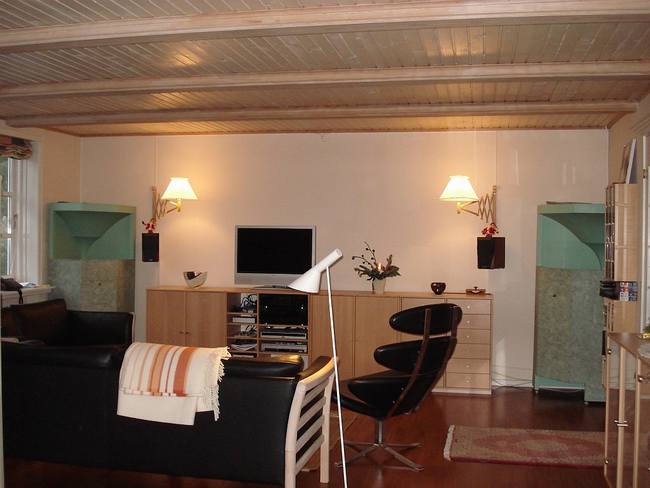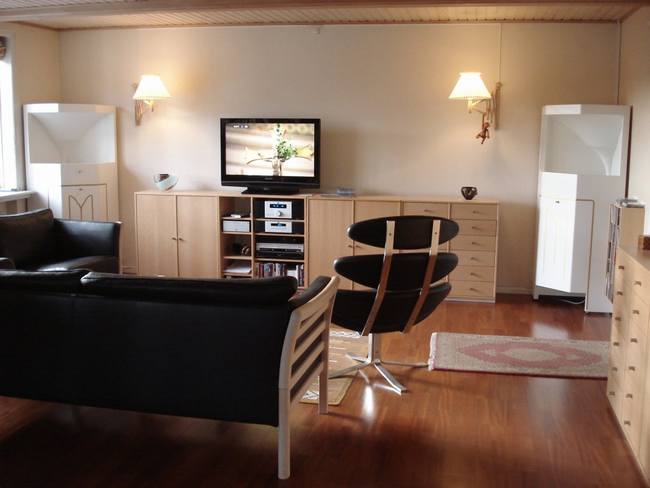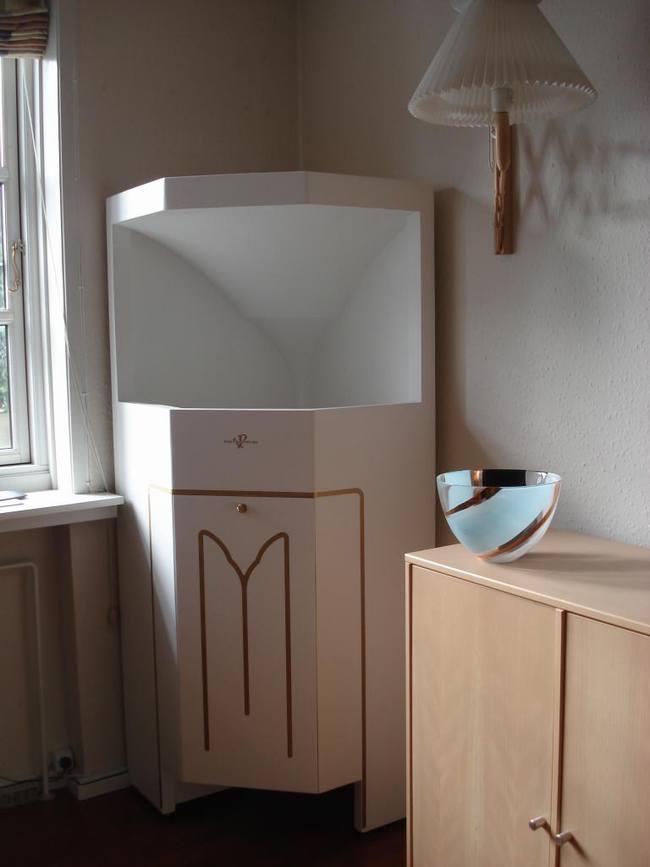|
Bjarne's loudspeaker system of today
The old Voigt horns have had fresh paint after this picture was taken - might improve the appearance a bit...

Gallery Update reveals that new colours can make a whole lot of difference...

The "new" loudspeakers really look stunning

Wauw - great job - Bjarne
Bjarne's own words about his system:
My loudspeaker system today consists of two full-range corner horns, with a mono subwoofer.
Therefore, I use just a single Ground Sound DCN23 unit.
The full-range corner horns are original Voigt Domestic Horns from the 1930's.
The left one is s/n 44 from 1934, originally sold to the BBC, and the right one is s/n 152 from 1937,
originally sold to a Mr. Bartholemew. They are surprisingly similar in manufacture, material etc.
They are, today, fitted with Lowther EX 4's.
Although the two horns have a quite capable reproduction as they are, I use the DCN23 to relieve the
delicate Lowther diaphragms from the lowest frequencies, below 60 Hz, by crossing over to the subwoofer.
Also, I use the DCN23 for slight equalisation by dampening the Voigt horns at 2-300 Hz, 1-2 KHz, 4-8Khz.
For this, I used a Clio software and microphone.
Furthermore, I use the DCN23 to take out one room resonance at 31 Hz.
For this, I used a Room Analyser from XTZ.
My stereo system is simple consist only of a XTZ D3 class A pre/main amp, a XTZ CD100 and a Hypex UcD400
Class D amp, and of course the DCN23.
The Class A amp drive the full-range horns via a 10 ohm resistor, as advised by mr. Nelson Pass. I entirely
agree to his recommendations regarding amplifiers driving horns with efficient loudspeakers -
White Paper.
The improvement at lower frequencies can be heard as well as measured.
The Class D amp drives the subwoofer, which is a band-pass reflex system, with two KEF B139 in a push-pull (isobarik)
configuration in order to limit cabinet size (150 l). -3db point is 23 Hz. From the pics. you can see I use a large
diameter duct. The penalty for this is a long duct. I found out that that duct resonated vividly at 280 Hz. To dampen
this, I first tried a "Pan-flute" termination of the duct inside. It worked, but did not suffice. Then, I tried a
Helmholtz resonator, 2,5 liters, tuned to 280 Hz. It worked excellently ! The peak at 280 Hz is all gone, and the
bandwidth of the sub extends beyond 500 Hz. Great fun ! So now you're inspired ?
As you can see, I selected a Hi-Fi 2000 enclosure type Galaxy, no. 1GX288.
I decided to use a LEMO connector for the USB interface, due to the quality, discrete nice look and easy mount
of the chassis female part. Male and female typeno's. are FGG.1B.304.CLAD42, and EGG.1B.304.CLL.
The capacitors you can see on the perf-board at the output of DCN23 are a precaution recommended by Ground Sound.
In some cases DC may appear (shortly) during adjustment and fiddling with the DCN23 / X-Over Wizard. Although not entirely
necessary, I have included them anyway, in order to protect my Lowthers as much as possible. The perf-board also includes
1:4 voltage dividers for the High-Pass channels, due to the high efficiency of the horns, and to keep up the signal amplitude
thru the DCN23, for lowest noise.
I am very content with my system as it performs today. The simplicity, low distortion, and absence of hum, hiss and noise,
combined with the clarity and "forward reproduction" of the Voigt horns, gives me a full fill ment that has made me come to
rest in terms of the itch to try something else.... at least for a while.
|
 active@groundsound.com
active@groundsound.com
 active@groundsound.com
active@groundsound.com